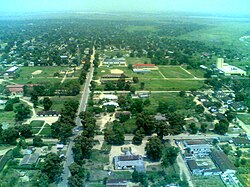This article needs additional citations for verification .(December 2014) |
Bandundu | |
|---|---|
Provincial capital and city | |
| Ville de Bandundu | |
 View of city center from the air, 2007 | |
| Coordinates: 3°19′S17°22′E / 3.317°S 17.367°E | |
| Country | |
| Province | Kwilu |
| City status | 1969 |
| Communes | Basoko, Disasi, Mayoyo |
| Government | |
| • Mayor | Moïse Monshengo [1] [2] |
| Area | |
• Total | 222 km2 (86 sq mi) |
| Elevation | 321 m (1,053 ft) |
| Population (2012) | |
• Total | 143,435 |
| • Density | 646/km2 (1,670/sq mi) |
| Time zone | UTC+1 (West Africa Time) |
| Climate | Aw |
Bandundu, formerly known as Banningville or Banningstad, is the capital city of Kwilu Province of the Democratic Republic of the Congo. [3]







